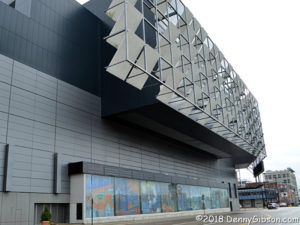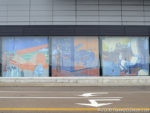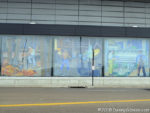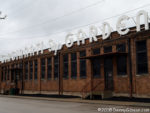 Attending the Cincinnati Museum Center preview last week reminded me that I’d sort of lost track of the murals that once hung in the terminal’s passenger concourse. When the concourse was demolished back in the 1970s, they were moved to the Cincinnati Airport in northern Kentucky. They once again became homeless when the airport terminal they were installed in came up for demolition. A new home was found on the west side of the Duke Energy Convention Center and they took up residence there about a month ago. You can read about the re-dedication ceremony here. Those panels above the murals form the city’s name tag. Anyone visiting or even passing through Cincinnati at night may have seen the name spelled out in lights. I apologize for this crappy picture being the only one that I own but I know there are some good ones out there on the web.
Attending the Cincinnati Museum Center preview last week reminded me that I’d sort of lost track of the murals that once hung in the terminal’s passenger concourse. When the concourse was demolished back in the 1970s, they were moved to the Cincinnati Airport in northern Kentucky. They once again became homeless when the airport terminal they were installed in came up for demolition. A new home was found on the west side of the Duke Energy Convention Center and they took up residence there about a month ago. You can read about the re-dedication ceremony here. Those panels above the murals form the city’s name tag. Anyone visiting or even passing through Cincinnati at night may have seen the name spelled out in lights. I apologize for this crappy picture being the only one that I own but I know there are some good ones out there on the web.


 The nine 20 feet square murals are in a climate controlled space behind tinted glass. That’s good for the murals which deserve all the protection they can get, but not so good for taking photographs. That bit of glare is a just minor inconvenience, however, and I’m certainly not complaining. I’m really quite happy to see the murals both protected and accessible. Passersby can now study these nine images of Cincinnati history with out so much as a train or plane ticket.
The nine 20 feet square murals are in a climate controlled space behind tinted glass. That’s good for the murals which deserve all the protection they can get, but not so good for taking photographs. That bit of glare is a just minor inconvenience, however, and I’m certainly not complaining. I’m really quite happy to see the murals both protected and accessible. Passersby can now study these nine images of Cincinnati history with out so much as a train or plane ticket.
 And here’s a bit of relocated Cincinnati history I’ve been remiss in checking out. I saw sketches of this installation while Cincinnati Gardens, the letters’ original home, was still standing. I mentioned the plan when I wrote about the Gardens in this post. Then I read about it being completed here. I can’t say why it took me nearly three months to get to see it but sometimes that happens. Cool and clever.
And here’s a bit of relocated Cincinnati history I’ve been remiss in checking out. I saw sketches of this installation while Cincinnati Gardens, the letters’ original home, was still standing. I mentioned the plan when I wrote about the Gardens in this post. Then I read about it being completed here. I can’t say why it took me nearly three months to get to see it but sometimes that happens. Cool and clever.

What’s the over/under on those murals holding up after being blasted by the sun every day?
Great question but one I can kinda duck by saying I imagine it’s at least over my life expectancy and can only hope it’s not under yours. The article on the dedication talks about state-of-the-art enclosures along with monitoring and adjusting the intensity and spectrum of light reaching the murals but without identifying the technology involved. For the present, I’m going to just be optimistic and hope they 1) know what they’re talking about and 2) wash the windows once in awhile.